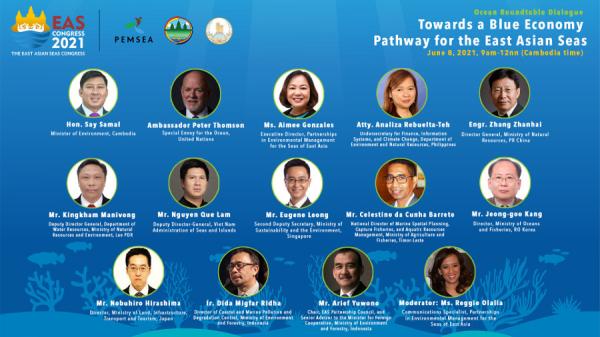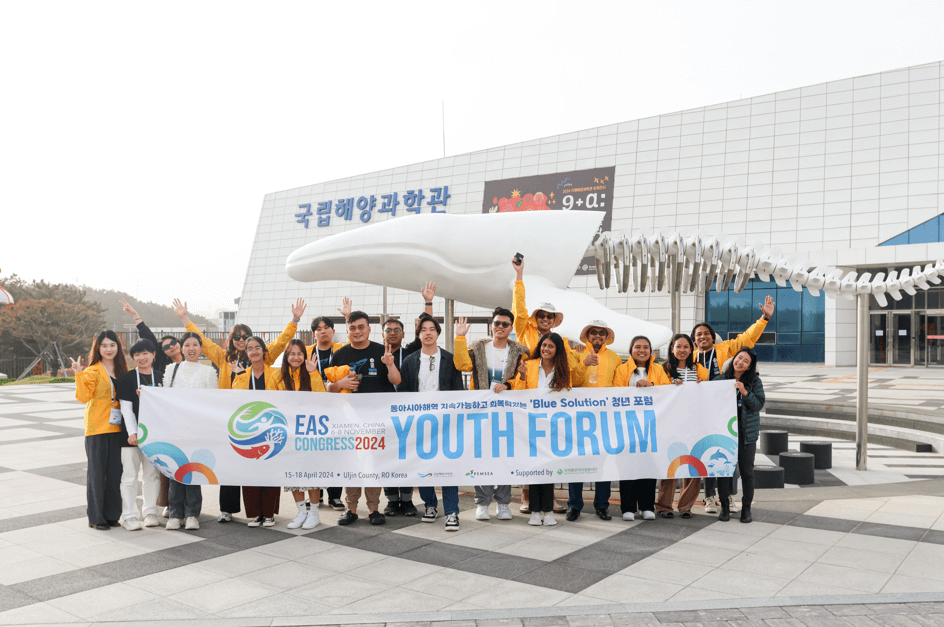East Asian Seas Countries Share Blue-Green Economic Recovery Plans Post COVID-19
Tuesday, 29 June 2021

SPECIAL FEATURE
MANILA, PHILIPPINES—For many countries worldwide, the ongoing COVID-19 pandemic has disrupted many people’s lives, the Gross Domestic Product (GDP) plunged, and unemployment rates soared along with a host of environmental challenges as countries focused on response and recovery efforts, making it challenging to achieve international, regional and national commitments on climate change, biodiversity conservation, marine pollution, and other aspects of coastal and marine governance.
Last June 8, 2021, Partnerships in Environmental Management for the Seas of East Asia (PEMSEA) organized a virtual Ocean Roundtable Dialogue to coincide with World Ocean Day aimed at supporting collaborative actions to harness blue economy in post-pandemic recovery plans. Called “Towards a Blue Economy Pathway for the East Asian Seas,” the event was the first in a series of Collabs (technical workshops) and served as the international launch of the upcoming East Asian Seas (EAS) Congress 2021 happening on December 1-2.
Formally opening the roundtable dialogue was Minister Say Samal of the Ministry of Environment (MOE) of the Royal Government of Cambodia, the host country of the EAS Congress. He announced that the event was an important start in crafting the EAS Roadmap to 2030 that will be presented and adopted during the 7th Ministerial Forum on December 2. The Roadmap will help secure the commitment and bolster more actions to achieve the goals and targets of the 2030 Agenda for Sustainable Development, the post- 2020 Global Biodiversity Framework, the UN Framework Convention on Climate Change (UNFCCC), the UN Decade of Ocean Science, and other regional and international commitments.
Related to Cambodia’s recovery plans, Minister Samal said the country “is properly implementing measures in response to the COVID-19 pandemic, which mainly are (1) to ensure the economic and social balance, with the increase of budgets on public healthcare, tax breaks, and cash supplements for the people; and (2) to promote economic growth through competitive environment, diversification, and reforms.” He added that “the Ministry of Environment remains focused on implementing our core policies, such as the National Strategic Development Plan, the National Policy on Green Growth, the National Environmental Strategy and Action Plan, and the Cambodia Climate Change Strategy that focus on pollution control and resource efficiency.”
Joining Minister Samal were Ambassador Peter Thomson, UN Special Envoy for the Ocean, who expressed his gratitude to PEMSEA for its efforts as the coordinating institution for implementing the Sustainable Development Strategy for the Seas of East Asia (SDS-SEA), its work on fostering integrated coastal management (ICM) solutions across the region, and its firm adherence to the principles of ecosystem-based management of coasts and seas. Ms. Aimee Gonzales, PEMSEA Executive Director, provided an overview of the pursuit of a sustainable ocean economy during and beyond the COVID-19 crisis in the EAS region. She shared that the EAS region has not only been recognized as the center of global marine biodiversity, but also as the center of ocean economy. In 10 countries in EAS, the ocean economy is estimated to be worth USD 1.4 trillion in value, with approximately 54 million people employed in ocean-related industries.
BLUE-GREEN RECOVERY PLANS
A series of country presentations from senior government officials from nine PEMSEA Country Partners, namely: China, Indonesia, Japan, Lao PDR, Philippines, RO Korea, Singapore, Timor-Leste, and Viet Nam then followed. The officials shared the challenges and opportunities of their respective countries in transitioning to a blue economy against the backdrop of the new normal.
The gross value added (GVA) of China’s coastal and marine sector reached CNY 8 trillion in 2020, reflecting a 5.3 percent decline compared to the previous year due to COVID-19. Coastal tourism, which dominates the ocean economy in China, is the largest affected sector. Chief Engineer Zhanhai Zhang, Director General of the Ministry of Natural Resources (MNR), shared that to help rebuild enterprises and restore the ocean economy, the MNR and Shenzhen Stock Exchange launched a series of activities to broaden the financing channels for small and medium-sized enterprises (SMEs). Coastal local governments have also introduced relevant policies and measures to help enterprises resume operations.
In Indonesia, the government developed the National Economy Recovery Program to mitigate the impacts of COVID-19 on the economy. Mr. Dida Migfar Ridha, Director of Coastal and Marine Pollution and Degradation Control, Ministry of Environment and Forestry (MoEF), shared that the activities under the program include: labor-intensive mangrove planting, peatland restoration, and the creation of coral reef gardens. He also emphasized that oceans are vital to Indonesia’s prosperity through economic activities such as aquaculture, tourism, marine construction, and maritime transport. Indonesia is also the world’s second largest fish producer.
Japan’s focus is on achieving carbon neutrality in 2050 following Prime Minister Suga’s declaration. To achieve a carbon-neutral society, it is important to accelerate the development of the needed R&D, and advance the use and adoption of digital technology in environmental management. Mr. Nobuhiro Hirashima, Director for International Ocean Affairs of the Ministry of Land, Infrastructure, Transport and Tourism (MLIT), also discussed the country’s Green Growth Strategy, which lays out the national vision and goals to motivate business players while serving as official reference on both the energy policy and outlook for achieving Japan’s carbon neutrality target by 2050.
For Lao PDR, Mr. Kingkham Manivong, Deputy Director General of the Department of Water Resources (DWR), Ministry of Natural Resources and Environment (MONRE), raised the importance of Lao’s water resources to the country and the surrounding region. At least 90 percent of the country is located in the Mekong River Basin, and 35 percent of the annual flow in Mekong is from Lao tributaries. Laws, policies, and initiatives have been instituted to facilitate integrated water resource management (IWRM) in Lao PDR such as: the creation and adoption of the amended Water Law, National Water and Water Resource Management Strategy and Action Plan; Groundwater Management Decree; guidelines on user fees related to natural resources, and water use permission system for companies; updating of the national groundwater profile; and monthly monitoring of water quality in river basins.
Persistent environmental challenges faced by the coastal and marine sector in the Philippines has led to unsustainable fishing practices resulting in the loss of approximately USD 101.9 million annually. While several laws and policies exist on coastal management, their implementation remains fragmented due to inadequacies in institutional capacity and access to financing and technology. Undersecretary Annaliza Rebuelta-Teh of the Department of Environment and Natural Resources (DENR)said the government is looking into the following measures: nature-based job creation; digitalization of the coastal and marine sector, investments in sustainability upgrades; adoption/passage of relevant laws and policies; investments in emerging industries such as renewable ocean energy and marine pharmaceutical products; and enhancement of the ocean economy accounts.
In RO Korea, marine litter has dramatically increased following the use of disposable plastic products due to the global response to the COVID-19 pandemic. Mr. Jeong-goo Kang, Director of the Ministry of Oceans and Fisheries (MOF), presented the country’s initiatives to address the problem: engagement of marine environment keepers; adopt-a-beach program; construction of two clean-up vessels and establishment of their operating group; replacement of buoys; and 2021 Partnering for Green Growth and the Global Goals 2030 (P4G) Summit.
On February 2021, Singapore launched its Singapore Green Plan 2030, a whole-of-nation master plan that aims to advance the country’s national agenda on sustainable development and strengthen their ongoing efforts to fulfil the country’s obligations under the Paris Agreement and support the achievement of the UN Sustainable Development Goals (SDGs). Mr. Eugene Leong, Second Deputy Secretary of the Ministry of Sustainability and the Environment (MSE), shared the five key pillars of the plan: (1) city in nature; (2) energy reset; (3) sustainable living; (4) green economy; and (5) resilient future.
Timor-Leste has been promoting integrated coastal management (ICM) for the past 25 years and has also developed local State of the Coasts reports in order to provide the baseline status of coastal resources in the municipalities of Dili, Manatuto, and Liquica to facilitate the monitoring and evaluation of ICM in these sites in the succeeding years. Mr. Celestino da Cunha Barretto, National Director of Marine Spatial Planning, Capture Fisheries and Aquatic Resources Management of the Ministry of Agriculture and Fisheries (MAF), said that a cross-sectoral, multi-agency approach that works at various geographical sites is needed to promote blue economy. He added that despite the shift in the government’s focus on health, economy, and tourism in line with COVID-19 response and recovery, Timor-Leste has been allocating sufficient manpower and resources to address coastal and marine-related issues.
In Viet Nam, COVID-19’s significant economic impacts on tourism, transportation, retail trading, and manufacturing is driving the country to successfully control the outbreak and move towards a safe reopening, stabilization, and resilience building of the economy. Mr. Nguyen Que Lam, Deputy Director-General of Viet Nam Administration of Seas and Islands (VASI) shared several existing policies that support the advancement of blue economy in Viet Nam, such as the master plan for implementing Viet Nam’s Marine Economy Sustainable Development Strategy. The said strategy aims to successfully develop the country’s marine economic sectors, listed in order of priority: (1) tourism and marine services; (2) maritime industries; (3) offshore oil, gas, and other mineral resources; (4) aquaculture and capture fisheries; (5) coastal development; and (6) ocean-based renewable energy and new/emerging marine economic sectors.
In his closing remarks, EAS Partnership Council Chair Mr. Arief Yuwono said that PEMSEA is preparing its Roadmap to 2030 so the information shared by the Country Partners will help inform plans and actions in the coming years. The Roadmap will serve as PEMSEA’s post-pandemic playbook which aims to put blue economy at the core of the region and the countries’ economic recovery plans.
“Our success in ‘building back better’ will depend on the decisions and actions taken by all of us in the region. The ocean community, public and private, as well as local, national and international actors, must jointly take decisions and actions that will determine to what extent and how fast our recovery from the crisis is, and secure our vision of healthy oceans, people and economies,” he added.
The recorded livestream of the Ocean Roundtable Dialogue can be accessed on Youtube.
For more information, visit the EAS Congress 2021 website at https://dev-pemseaorg.pantheonsite.io/node/91
MEDIA CONTACT:
(Ms) Reggie U. Olalia
PEMSEA Communications Specialist
Email: rolalia@pemsea.org
(63-2) 0917-9028121



